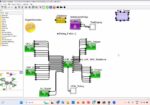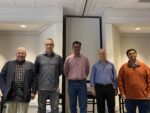MosChip is a publicly traded company founded in the year 1999, they offer semiconductor design services, turnkey ASIC, software services, and end-to-end product engineering solutions. The company headquartered in Hyderabad, India, with five design centers and over 1300 engineers located in Silicon Valley (USA), Hyderabad, Bengaluru, Ahmedabad, and Pune. MosChip has over two decades of track record in designing semiconductor products and SoCs for computing, networking, and consumer applications. Also, MosChip has developed and shipped millions of connectivity ICs.
Tell us a little bit about yourself.
Hello, I’m Srinivasa Kakumanu, commonly known as KS. I’ve been in the semiconductor industry for over 28 years now. One of my notable accomplishments was co-founding First Pass Semiconductors Pvt Ltd, a prominent VLSI design services organization established in December 2010. Throughout my illustrious career, I have played a key role in leading numerous ASIC tape-outs across the Communication, Networking, Consumer, and Computing sectors.
Under my leadership, First Pass experienced significant growth, evolving into a thriving organization boasting more than 210 employees by FY18. This remarkable journey culminated in the acquisition of First Pass by MosChip in July 2018, all the while maintaining profitability since inception. Following the acquisition, I was responsible for the role of heading the Semiconductor Business Unit at MosChip, steering it to remarkable heights.
Before my tenure at First Pass, I held the position of General Manager for the VLSI group at Cyient (formerly known as Infotech Enterprise) in India. My career also includes stints with notable organizations such as TTM Inc. in San Jose, US; TTM India (both were acquired by Infotech in September 2008) Pvt. Ltd. in Hyderabad, India; Ikanos Communications in Fremont, US; QualCore Logic Ltd in India, and HAL in Hyderabad, among others.
I also maintain my professional education commitment by actively teaching Digital Design and Physical Design at MosChip Institute of Silicon Systems Pvt. Ltd, a training institute that I co-founded, which was subsequently acquired by MosChip in July 2018. My international experience includes a seven-year tenure in the United States between 2000 and 2007, where I contributed to TTM Inc. and Ikanos Communications.
What was the most exciting high point of 2023 for your company?
MosChip has reached new heights in the year 2023, with some remarkable achievements. Firstly, we were honored to be recognized among India’s Top 150 Growth Champions and Asia-Pacific’s Top 500 high-growth companies by institutions like the Economics Times, Financial Times, and Statista. This recognition shows our ongoing dedication to excellence and innovation in the semiconductor industry. Adding to this, On March 31, 2023, Softnautics, a semiconductor and software AI solutions company situated in California, was acquired by MosChip Technologies. This acquisition made us more powerful in the software sector and strengthened our portfolio and capabilities, setting us up for worldwide success. We also welcomed Dr. Naveed Sherwani, a veteran of the semiconductor industry, to our Board of Directors with great pleasure. His knowledge will surely help us make better strategic decisions and drive our company forward.
On top of that, being recognized by Qualcomm as the most valuable supplier in the software category for 2022 confirmed our commitment to providing high-quality solutions and forming solid partnerships. Also, Receiving the EE Times Asia Awards 2023 for the Most Influential Corporate in ASIA consecutively for 2 times was a humbling affirmation of our semiconductor industry excellence.
These milestones of 2023 motivate our determination to continue pushing boundaries, driving growth, and making a positive impact in the semiconductor and software sectors.
What was the biggest challenge your company faced in 2023?
The biggest challenge we faced in 2023 was a shortage of qualified chip design engineers in India’s semiconductor industry. The industry’s slow pace and hiring challenges triggered the situation. Despite increasing growth, hiring and finding skilled professionals, especially senior technical leaders, was tough. This challenge restricted our capacity to meet industry demands but with my team and support from the other leaders, we made it through.
How is your company’s work addressing this biggest challenge?
To address this challenge, MosChip has taken significant initiatives to develop new talent in the semiconductor and software fields with our indigenous institute for finishing schools, the “MosChip Institute of Silicon Systems (M-ISS)” which I co-founded and later on MosChip acquired, where we educate and develop aspiring chip design and software engineers, providing them with the training and experience with hands-on experience on the tools that industry professionals use to get them ready for the market. By cultivating these talents through our institute, we can close the skill gap and contribute to the growth and sustainability of India’s ecosystem.
What do you think the biggest growth area for 2024 will be, and why?
From my perspective, the semiconductor and software (both Digital Engineering and Device Engineering) market is expected to expand significantly this year. On the semiconductor front, next-generation memory technologies such as MRAM, ReRAM, HMC, and HBM have moved from studies to industrialization, with leading foundries and integrated device manufacturers (IDMs) qualifying STT MRAM technology for a wide range of applications including power-efficient MCU/SoC chips, ASIC products, IoT devices, wearables, and CMOS image sensors. On top of that, the system design market is predicted to expand significantly in 2024, led by increasing consumer demand for electric vehicles (EVs). Plus, it is expected that there will be a significant increase in various sectors such as telecommunications, healthcare, industrial IoT, consumer electronics, military, and aerospace. Emerging trends like Chiplets, RISC-V, and AI/ML present exciting opportunities for innovation, which will help MosChip maintain its position as a leader in the industry. This will contribute to the overall growth of the semiconductor, software, and systems industries.
https://www.linkedin.com/pulse/embedded-systems-market-growth-trends-forecast-2024-l0cxf/
How is your company’s work addressing this growth?
We are actively tackling the significant increase expected in the semiconductor, software, and systems markets by 2024. We devote ourselves to technological advancement to enhance next-generation memory technologies, collaborating with industry leaders to ensure our products exceed strict requirements. With the recent acquisition of Softnautics, we are deepening our expertise in Digital Engineering and Device Engineering and positioning ourselves to take advantage of opportunities in both areas. Overall, our strategic activities are aimed at capitalizing on growth prospects and strengthening our position as a significant leader that can lead us to conquer the semiconductor, software, and systems industries.
Will you attend conferences in 2024? Same or more?
Yes, we plan to make our conference attendance more than what we did earlier to cover our major geographies to meet the customers from USA, India, & Europe. Unlike the previous focus on semiconductor-specific events, We are now looking for more events covering Semiconductors, Product Engineering & AI/ML, etc. Although we value the importance of networking and staying up to date with industry developments at these events, our decision to attend will be based on how relevant the conference is to our company’s goals and priorities for the year.
Additional questions or final comments?
As we look ahead, we want to highlight our incomparable dedication to our customers and stakeholders. We focus on offering high-quality solutions and maintaining strong relationships that create mutual success. Our commitment to customer satisfaction and exceeding expectations is at the bottom of everything we do. As we come up with ever-evolving solutions for the semiconductor, software, and systems industries, our customer-centric approach will stay constant, ensuring that we remain a trusted partner and industry leader for many years to come. We firmly believe that our employees are our biggest asset and as such, we continuously prioritize their development and welfare.
Also Read:
CEO Interview: Larry Zu of Sarcina Technology









